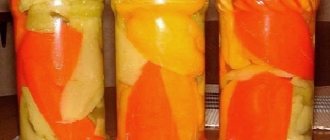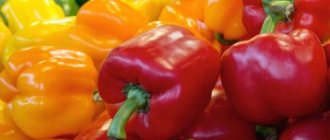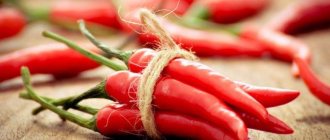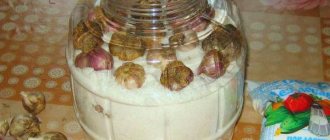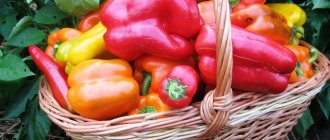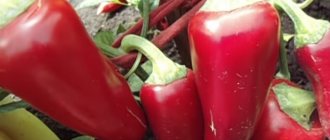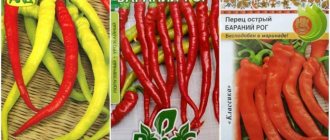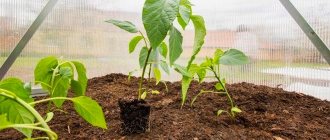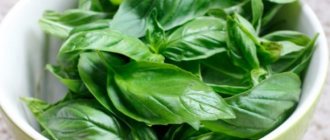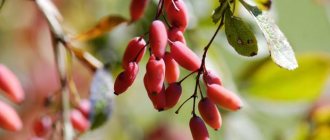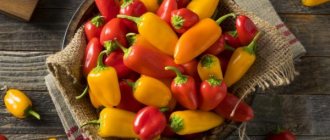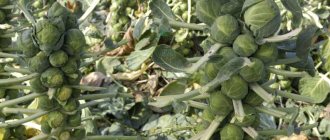Friends, I recently reaped a rich harvest from my peppers (this year they bore fruit like never before). At that moment I started thinking: how to store bell peppers at home? To my surprise, I found several ways that I would like to share with you.
With proper storage, the beneficial properties of the vegetable remain unchanged.
Choosing the right pepper for long-term storage
When growing peppers in your garden, you need to know that the vegetable has two degrees of ripening:
- technical;
- biological.
Technical maturity is those fruits that have not reached full ripening. Most often they are already the right size, but still painted green. Such vegetables removed from the bush can retain freshness until the New Year holidays.
Biological maturity - the fruits are brightly colored: yellow, red, orange or dark purple. Such peppers must be immediately processed or used in cooking. The maximum shelf life is no more than 1.5-2 months.
To preserve vegetables for a long time, you must follow simple rules:
- When technically mature, it can be stored for a long time and is suitable for transportation and sale.
- Technically mature fruits are harvested weekly, before the onset of the first cold weather.
- Peppers collected at technical maturity can retain freshness and beneficial properties for up to 2-3 months.
- Pungent fruits are collected as they ripen, only at the stage of biological ripeness.
- Harvesting must be done before the first frost, as frozen peppers lose their shelf life.
Canning
This method is suitable for storing damaged fruits. The vegetable can be added to vegetable salads for the winter or prepared separately.
Canned pepper pieces
Remove seeds from fruits. Cut into cubes. Place in layers in a jar, sprinkling with salt. Close the lid tightly. This preparation for first and second courses must be stored in the refrigerator. The shelf life of the product is 4–5 months.
Pepper puree
This preparation can be used as a seasoning for soups and main courses. For cooking, you need to select ripe fruits. Remove stalks and seeds from them. Cut into pieces and puree in a blender. Add salt to taste. Place the seasoning into small jars. Pour a spoonful of sunflower oil on top. Should be stored in the refrigerator for no more than 1 year.
Bell peppers are a flavorful addition to the winter diet. In addition to excellent taste, this product has beneficial properties that will strengthen the immune system during the cold season.
Best varieties for storage
For long-term storage, varieties with good shelf life and transportability are used. Mid-season and late-season varieties are better preserved.
| Photo | Description |
Beglitium | At biological maturity they acquire a dark red color. High-yielding variety, large fruits |
Martin | The most common high-yielding variety with increased shelf life. The fruits are cylindrical in shape, colored light green at technical maturity, and red at biological maturity. |
Novogoshary | A mid-early variety with rounded-flattened red fruits. Valued for its increased shelf life and transportability |
Red Baron | Hybrid variety. In technical ripeness, the fruits are colored bright lilac, in biological ripeness - dark red. |
Black cardinal | A late variety with fruits of dark purple color during the period of removable maturity and red in biological |
Aristotle ex 3 r | Hybrid variety with large cylindrical fruits. The color changes from dark green to deep red. Features unsurpassed appearance and taste |
How to ripen pepper
Various methods are used to ripen bell peppers. How to store peppers so they turn red faster? To do this, place several red or yellow ripe vegetables between the collected fruits and place them in a warm, dark place for 4-5 days.
Temperature and storage conditions
For long-term maintenance, peppers are picked at the stage of technical ripeness. They are placed in 3 layers in small containers, which are left in a room with a temperature of +10...+12°C and an air humidity of 85–90% . Under such conditions, the fruits fully ripen in 1 month. After this, the temperature is lowered to 0°C to prevent the development of diseases. In room conditions, ripening is much faster.
One way to store fruits in a basement or cellar is to hang the bushes directly with the roots. Plants are planted at home in flower pots or wooden boxes for further ripening of vegetables.
Lifehacks
To speed up fruit ripening, various methods are used:
- during the period of vegetative growth of bushes, weak shoots are pinched and cut off;
- during fruiting, foliar feeding is applied: solutions of potassium and phosphate fertilizers are used;
- at the end of August, the remaining flowers are removed;
- in early to mid-autumn, small peppers that have not yet had time to ripen are picked. This will give the bushes the strength to grow large fruits before the onset of cold weather;
- to speed up the ripening of vegetables, at the end of autumn the crop is watered with warm water (+45...+50°C) at the root, without touching the green mass;
- in autumn, during cold nights, the bushes are covered with agrofibre or plastic film;
- tear off most of the leaf mass from plants for better ripening of fruits;
- To make vegetables ripen faster, at the end of the season they loosen the soil around the bushes as deeply as possible.
Peppers 2021. Ripening green fruits is SIMPLE!!!
Degrees of maturity
Fruits go through two stages of maturity: technical and biological.
At technical ripeness, vegetables reach optimal size, taste and beneficial qualities, but have not yet acquired the color characteristic of the variety. After harvesting, such fruits are transported, stored, and sold.
Vegetables at the stage of technical maturity are green or pale yellow, sometimes almost white. They are selectively removed every 6–8 days. Harvesting occurs at the end of autumn, before the onset of the first frost. With the advent of constant cold weather, the remaining harvest is completely harvested.
If you place the fruits in a warm, bright place, they will acquire the appropriate color in a short time.
Biological maturity is the physiological ripeness of peppers when they acquire their final color, becoming red, yellow, orange.
Reference! If bell peppers are picked at this stage, they will not keep for long.
It takes 3-4 weeks from technical to biological maturity of vegetables. During this period, the content of vitamins, sucrose and other valuable substances in the fruit increases.
The degree of biological ripeness of bell peppers is determined by gently pressing on the skin. If you hear a slight crunching sound, it means the vegetables are fully ripe.
Preparing vegetables for storage
Before you start harvesting pepper for the winter, you need to first prepare it. Since this vegetable is tender, it is cut from the bush very carefully using pruning shears.
The harvested crop is wiped with a damp cloth and laid out in a cool, dry place to identify unsuitable specimens. After 7 days, strong, undeformed fruits are selected, most of the stalk is cut off, leaving a small tip.
Each pepper is dipped in a 1% solution of copper sulfate and sent to dry. After these procedures, the vegetable is ready for storage for long-term storage.
If frosts occur and the harvest has not yet been harvested, it is necessary to cut off the unripe fruits and place them in a dry room. In a month, all the peppers will ripen and be ready to eat.
Is it possible to remove unripe bell peppers?
Peppers at the period of technical ripeness have not yet acquired the color corresponding to them, but are quite suitable for consumption. Can such fruits ripen? Yes, if you keep them in a warm place. If you add other ripe vegetables along with green peppers, ripening will occur faster.
Why film
Unripe vegetables are removed from the beds when they face long transportation or are expected to freeze. During transportation and being on store shelves, peppers reach biological ripeness. If you pick and transport them when ripe, the fruits will quickly begin to deteriorate.
In summer cottages, vegetables are harvested before they are fully ripe so that new ovaries are formed. This increases the amount of harvest from each bush.
How to preserve sweet peppers
Bell peppers can be preserved in two ways: fresh and frozen.
If a sweet vegetable is dried, it will lose its crunch and juiciness, which is why many Russians love it.
Storing peppers at home
Storing peppers at home is not easy, but quite effective. There are several ways to store bell peppers - on the balcony, in the refrigerator, at room temperature.
By choosing one of the methods, you can provide yourself with healthy vegetables until the New Year holidays.
On the balcony or loggia
A glassed-in balcony is the best place to store peppers. Storage time depends on climatic conditions and degree of ripeness.
If you plant semi-ripe vegetables in October at a temperature of +10 degrees, then within a month they will ripen, and by December, when the temperature gradually decreases, they will go into a dormant stage. They can remain in this position for 2-3 months.
The best weather for storage is 0-+2 degrees. The higher the temperature, the shorter the shelf life; at sub-zero temperatures, the fruits will begin to deteriorate.
A wooden box is prepared for storage on the balcony. Each fruit is wrapped in paper or in a separate plastic bag, in which holes are made for ventilation.
The box is placed in a dark place away from direct sunlight. When cold weather sets in, the container can be wrapped in a blanket so that sub-zero temperatures do not destroy the crop.
At room temperature
If there is a lot of harvest and frosts occur, the bush should be carefully dug up and transplanted into a flower pot. Choose a cool place for the plant.
Before bringing it into the house, it must be treated against insect pests so that it does not infect indoor flowers.
The peppers are watered from time to time and harvested in a timely manner. If you maintain temperature and humidity conditions, you can enjoy this healthy vegetable throughout the winter.
In a refrigerator
One of the options for storing pepper at home. To do this, the ripe fruits are placed in the vegetable compartment of the refrigerator. There vegetables can remain fresh for 3 months. Unripe peppers are not suitable for this method. They will not be able to ripen in the refrigerator, but they will spoil very quickly.
Before storing in the refrigerator, the peppers are washed, dried and rubbed with vegetable oil. After rubbing, they retain their elasticity and freshness. Each prepared specimen is wrapped in cling paper or film. You can also lay them in plastic bags, not forgetting to make ventilation holes.
In the freezer
A simple and convenient way. After defrosting, the fruits do not lose their appearance and beneficial properties.
To do this, select strong, healthy peppers at biological maturity, wash and dry them. The core of each is removed, the caps are not thrown away. Cook the prepared peppers for 30 seconds and leave to cool. Cooking is necessary to impart flexibility and elasticity.
The cooled vegetables are placed one inside the other, being careful not to damage them. Each structure is placed in a plastic bag, and the voids are filled with lids. They will not take up much space in the freezer, and after defrosting they are very difficult to distinguish from fresh ones.
This method is good because the pepper can be stored indefinitely.
Storing peppers in a country house
You can store peppers in a basement, barn or cellar. The main condition is that the air temperature does not drop below zero, and that the room is dry and well ventilated.
The prepared fruits are placed in layers in a box covered with paper, sawdust or sand. When placing peppers, you need to make sure that they do not touch each other. Each layer is sprinkled with river sand or sawdust.
Sawdust from resinous trees is not suitable, as the specific smell can be transferred to the peppers.
Recommended storage periods
The shelf life of semi-ripe bell peppers after harvest can be up to 6 months when stored fresh. The main condition for extending shelf life is air humidity of no more than 80% and temperature - +2 degrees. Residents of private houses can provide such conditions for the product when placing it in a basement or cellar, while apartment owners will have to free up space in the refrigerator; a box for storing vegetables is best suited.
Attention! The described shelf life applies to unripe peppers. Overripe ones will not last in the refrigerator for more than 2 weeks.
If you ensure freezing, you can preserve the pepper for a year, while the vegetable will not lose its taste and positive properties. The only thing that cold affects is a change in consistency; the product becomes more watery and soft after defrosting.
In some cases, it is permissible to store vegetables at room temperature, but the product must be provided with special conditions. Boxes should be located away from light and heat sources. When exposed to direct sunlight, the skin of the pepper suffers and blemishes appear on it.
How to preserve hot peppers
Bitter peppers or chili, unlike sweet ones, are removed from the bush only at biological maturity. It should be red, yellow or orange. This is explained by the fact that hot pepper contains a special substance that gives the vegetable its spiciness. The amount of this substance is directly proportional to the degree of maturity.
Hot peppers are less fleshy, so they are not susceptible to rotting. It does not spoil and can be stored dried.
There are several ways to store spicy varieties.
Drying in bunches
Each peppercorn is tied with a thread by its tail, forming a small bun. Prepared vegetables are hung in a cool, dry room with diffused light.
After drying, the vegetables are placed in jars and stored in a dark place. Dried peppers can also be ground and stored in jars or paper bags.
Storage in oil
Freshly picked hot peppers are washed and dried. Remove the stalks and seeds. If you need a hot vegetable, do not remove the seeds, since all the pungency is in them.
Prepared vegetables are placed in sterile jars and filled with warm refined oil. You can also add a few cloves of garlic and herbs to the pepper.
In this state it should brew for half a month. This method is good because the vegetables remain fresh and the oil acquires a piquant, islandy taste. And then it can be used as a salad dressing.
Preparation of semi-finished products
You can make frozen semi-finished products from bell peppers and, if necessary, remove them from the freezer and cook without defrosting in just a few minutes. The shelf life of such products is up to 1 year.
Mixed vegetables with sweet pepper
A mixture of various vegetables can be used to prepare soups, stews, and main courses. Combinations of products can be any, the main thing is that they are combined to taste. Suitable for bell pepper:
- Carrot;
- Green pea;
- Green beans;
- Broccoli;
- Corn;
- Onion.
To make the vegetable mixture, the products need to be washed and dried on a towel. Peppers, onions and carrots - cut. Mix all the vegetables and place them in portions in containers or bags. Place in the freezer.
Peppers can be stuffed with various fillings; frozen semi-finished products can be stored for about a year.
Stuffed pepper
Stuffed whole peppers make a satisfying main dish that takes no more than 40 minutes to prepare. You need to stuff the peppers in advance and freeze them. This method of storing pepper at home is one of the most labor-intensive, but the result is a delicious, complete dish for dinner or lunch.
For filling you can use:
- Chopped meat;
- Vegetables with rice;
- Minced meat with mushrooms;
- Seafood (shrimp and squid).
It is important that the filling is not liquid. To stuff peppers, you need to prepare the vegetable:
- Carefully cut the stem in a circle and remove the core with seeds.
- the fruits need to be washed and dried,
- fill with any filling to taste and place in the freezer individually to freeze while maintaining shape.
- After a day, collect semi-finished products in bags or containers in portions.
The maximum length of time you can store stuffed peppers in the freezer is 1 year.
The best varieties of hot peppers
All varieties of pepper originate from South and Central America.
Modern species differ in color and degree of pungency. There are a large number of contraindications. Before use, you should consult a specialist.
| Photo | Description |
Tula | A high-yielding early-ripening variety with large red cone-shaped fruits. The variety is high in vitamins and plastic |
Vizier | Late-ripening and medium-sharp variety. Ideal for canning, pickling and making paprika |
Astrakhan | Mid-season high-yielding variety. Grows well in regions with unstable climate. The bush is small, produces small red fruits |
Ram's horn | Mid-season unpretentious variety. With proper care, you can reap a generous harvest from the bush. Pods are red, elongated, slightly sharp |
Superchili | Early maturing hybrid variety. Productivity is high, fruits are cherry-colored when biologically ripe. Used fresh, dried and salted |
Features and timing of harvest
It is recommended to harvest the Bulgarian vegetable at the stage of technical ripeness, when the fruits are fully formed in size, but do not have the proper color. As a rule, the technical maturity phase begins 2.5–3 months after the formation of the first shoots.
The timing of technical ripening of fruits varies depending on the variety of pepper and in most cases is indicated on the package with seeds. Fruits collected during this period can be stored for two or more months, gradually ripening without losing their nutritional value and taste.
It will take several weeks for bell peppers to move from the technical phase of ripening to the biological phase. The duration of this process will be determined by several important factors: air temperature and humidity level.
The onset of the bioripening stage will be signaled by a change in the color of the pod - from green to orange, red or yellow, depending on the variety of crop. Also, the full ripeness of the fruit is indicated by a characteristic crunch that can be heard when pressing on the skin.
Unripe peppercorns do not have such a sound. Typically, harvesting is carried out selectively, several times a week, as the vegetable is ready. Full fruit harvesting is carried out when there is a risk of night frosts.
Optimal storage conditions
Bell peppers do not have good shelf life, so for their storage it is necessary to organize optimal conditions:
- The most comfortable temperatures for storing fruits are considered to be no more than +10°C, while the relative humidity should range from 80–95%;
- fruits for storage are placed in containers in 2-3 layers, if possible, each of them is wrapped in paper;
- pepper is stored in a room separate from all other vegetables, as it easily absorbs foreign odors;
- in refrigerator conditions, vegetables are stored at a temperature of no more than +9...+10°C and a humidity of not less than 80%;
- Fully ripe peppers are stored in a room with a temperature of 0 to +2°C and a humidity level of about 90%.
Periodically, all fruits in boxes are inspected for damage or rot. All bad specimens are discarded.
Important! Orange and red peppers last longer. Varieties with a green color quickly become unusable.
Read also:
06 March 2019
Apples with healing fruits
Humanity has known about the healing properties of fruits and vegetables for a long time. How…
Read
06 Mar 2019
Beet beetleaf (Cassida nebulosa)
Pest type: Sugar beet pest Series: Coleoptera-Coleoptera Family: leaf beetles-Chrysomelidae Found…
Read
06 Mar 2019
Keppel tree
Botanical name: Keppel (Stelechocarpus burakol). Belongs to the Annonaceae family. Is…
Read
